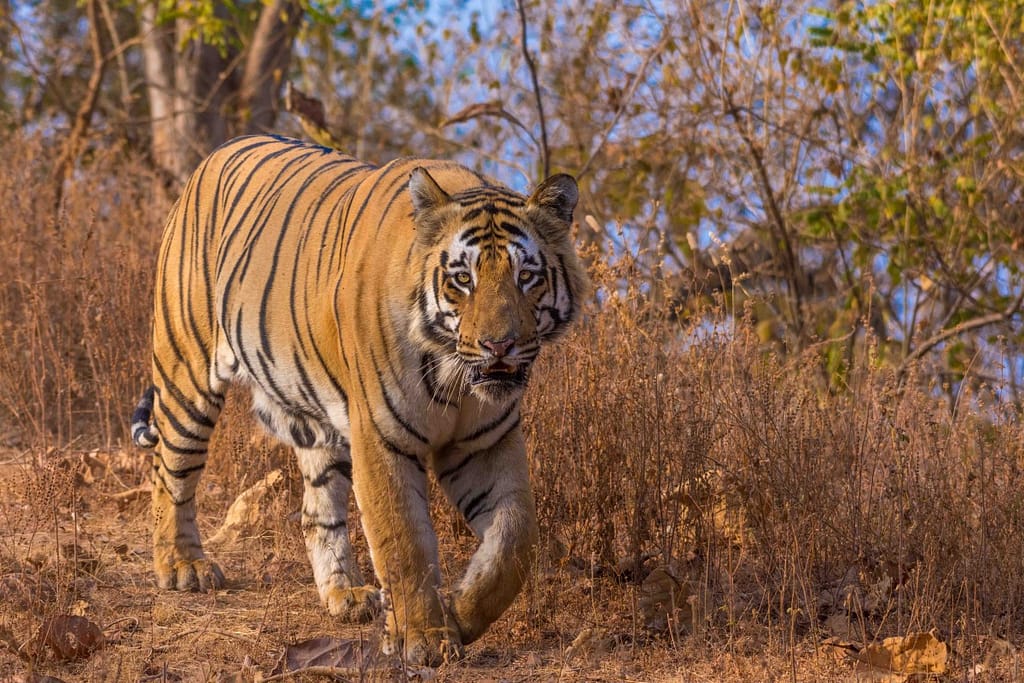The Pench National Park
The Pench National Park and Tiger Reserve extends over an area of 257 sq. km in the lower southern reaches of the Satpura hill ranges, along the northen boundry of Nagpur District.It was declared a National Park by the Government of Maharashtra in 1975 and received the official status of “Tiger Reserve of India” in February 1999.
The Park gets its name from the Pench River , which meanders through it like a mammoth python, dividing it down the center. Rich in its biodiversity, its terrain defined by hills, valleys and the occasional precipitous slope. Pench is an important ecosystem supporting an abundance of flora and fauna including a rich variety of aquatic life.
Not surprisingly, the beauty of this part of central India earned much literary attention.The poet Kalidas waxes eloquent about the scenic charm of the places in his epics Meghdootam and Shakuntalam.
Indeed, the Pench National Park is four different forest regions in one: an extravagance of trees, shrubs, grasses, climbers, weeds and herbs, with teak being the most prominent of the tree species. The park is home to 33 species of amphibians, 30 pecies of reptiles, and a wide variety of insects.
While officially reserved for tigers and panthers, Pench is also home to Sambar,Chital, Barking Deer, Nilgai, Black buck, Gaur, Wild Boar, Chausingha, Sloth Bears, Wild Dogs, Langurs, Monkeys, Mouse Deer, Black-naped hares, Jackals, Foxes, Hyenas, Porcupines, and Flying Squirrels, to name a few.

Here, birdlife is equally bountiful. The feathered denizens of Pench include both resident and migratory bird like Malabar pied hornbills, Indian pittas, ospreys, grey-headed fishing eagles, white-eyed buzzards, storks, waterfowls, four endangered vulture species, and the green pigeon, which is the State Bird.
This park is accessible from Pauni on National Highway 7 and has two famous gates as tourists entry, Turiya and Karmajhiri.
Pench is a naturalist’s dream come true, a mind-expanding experience if ever there is one.
Flora in Pench National Park
The forest is mixed and given the high rainfall precipitation one finds extensive stretches of Sal (Shorea robusta), a tree of moist deciduous forest in central and north India. The Sal is good quality timber, the leaves are good fodder, fruits have nutritional & medicinal value and is valued greatly by tribals. The other common tree species belong to the Terminalia genus, the most numerous being what in India is popularly known as Crocodile bark, the earlier Scientific name being Terminalia tomentosa, now it is referred to as Terminalia crenulata, it is good timber, locals call it as Saja and in Maharashtra it is called as Ain. Terminalia arjuna, locally called Arjun is distinct because of its pale bark and thick girth, is more common near water sources. Other Terminalia species are Terminalia chibula and Terminalia bellarica, Axle wood (Anogeisis latifolia), locally referred to as Dhaoda, good for making charcoal and agricultural implements is common. Labernum or Amaltas (Cassia fistula) with lovely yellow blossoms in the dry season and Flame of the forest or Palas (Butea frondosa) a glorious sight in the drier season when it is flowering, are found sprinkled all over the forest. Huge trees of Baja (Pterocarpus marsupium) & Haldu (Adena cardifolia) along with host of other large & small trees comprise the thick forest. Evergreen trees like Mango (Mangifera indica) and of Jamun or Black plum (Syzigium cumini) are also found. Bamboo thickets (Dendrocalamus strictus) are commonly found, the undergrowth is quite thick with species like Lantana and Glerodendron.

The rolling meadows of grass and grassy plateau are integral to the health of the herbivore population. In some areas wildlife management practices have deliberately prevented the progression of secondary and climax vegetation to ensure adequate grasslands for the herbivores. No note on flora can be complete without a note on tall luxurian tree, Mahuwa (Madhuca Indica). Flowers of the tree useful as food and are source of very popular liquor which is compared to Ambrosia or nector of the god.
Birds in Pench
Birds in Pench National ParkThere are over 285 species of resident and migratory birds including the Malabar Pied Hornbill, Indian Pitta, Osprey, Grey-headed Fishing Eagle, White-eyed Buzzard, etc. In winter thousands of migratory waterfowl including Brahmini Duck, Pochards, Barheaded Geese, Coots, etc visit the tanks and the Pench reservoir within the Park.
Pench Tiger Reserve is also among the best areas for bird watching. Four species of the now endangered vultures white-rumped, longbilled, white scavenger and king vulture can be seen in good numbers in the Reserve. The other fauna present include 50 species of fishes, 10 amphibians, 30 reptiles, 45 butterflies, 54 moths and numerous other insects.

Visiting Rule
The Pench National Park is open to visitors from 1st October to 30th June each year and remains closed during the rainy season.Visiting hours from 6 am to 11 am and 3 pm to 6 pm.Light vehicles and mini buses are allowed and speed restriction must be followed.
